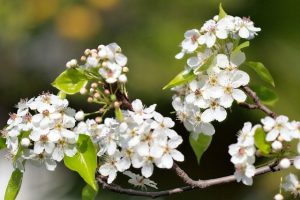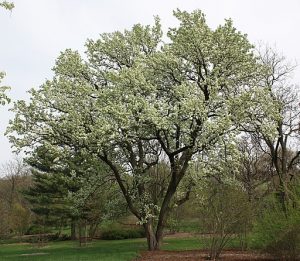Written by Patrick Boleman, Land Stewardship Manager East
Callery Pear (Pyrus calleryana)
With spring on the horizon, early-blooming plants are beginning to show their colors heralding the coming of warmer weather. Pinks from redbud trees, subtle reds from maples, and a myriad of colors from spring ephemerals are beginning to pop throughout the landscape. One of these admittedly beautiful flowers is the Callery pear (Pyrus calleryana), whose many white flowers make it appear to be covered in snow. In this Species Spotlight, we take a look at the Invasive Callery Pear and why it’s a problematic plant to avoid in your landscape. Look out your window as you drive along the highway or through your neighborhoods and you will be sure to see these pear trees in bloom. However, the Callery pear has a sinister reputation as a highly invasive non-native tree species.
The Callery pear is a medium-sized deciduous tree native to China introduced to the United States in the early 1900s. Many will recognize the early cultivar of P. calleryana, the Bradford pear, which was widely planted as an ornamental tree in urban and home landscapes. Bradford pear was touted for its variety of urban benefits such as tolerating poor growing conditions, quick development, and showy spring blooms. But with these benefits come costs. Bradford pear flowers have a notoriously foul odor, quick growth, and poor branch unions that lead to mature trees susceptible to branch failure. Originally, Bradford pear was a sterile cultivar, leading many to believe it would not become an environmental concern through naturalization. However, as more cultivars were developed, the Callery pear cultivars began to cross-pollinate, reproduce, and quickly escaped into the natural environment.
Callery pears are now one of the most invasive species in our landscape, as currently evidenced by the number of blooming trees seen along field edges, right-of-way corridors, and neighborhoods. At the Williamson Preserve, these invasive trees not only cause habitat degradation but also cause management issues due to their thorny stems as seedlings. Our stewardship staff has thrown many expletives their way when P. calleryana thorns pop tractor tires while bush-hogging and maintaining our grassland habitats. A real “thorn” in our side. Our avian friends will disperse pear fruits during the fall and winter, further distributing them to continue their invasion of our landscape.
Triangle Land Conservancy strongly encourages landowners not to plant Callery pears and remove them if possible. There are many native alternatives such as redbud, dogwood, and fringe tree, among others. Beyond their beautiful aesthetics, native trees provide ecosystem benefits such as food resources to many wildlife species and serve as host plants for the many pollinators whose populations need our help. So plant native and help our wildlife neighbors! Check out NC State Extension online resources for more information on Callery pear and beneficial alternatives for your home landscape.


